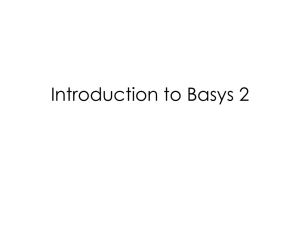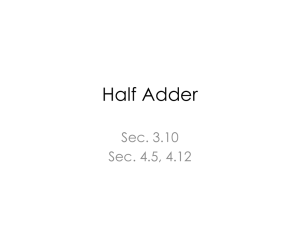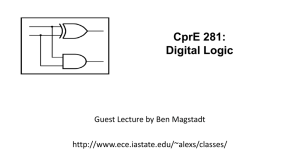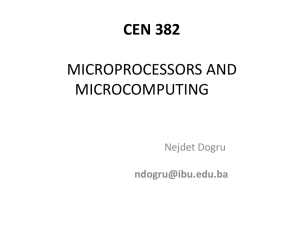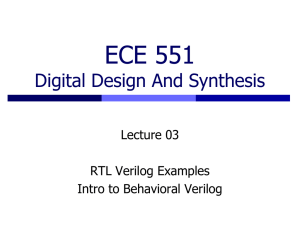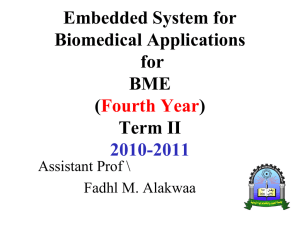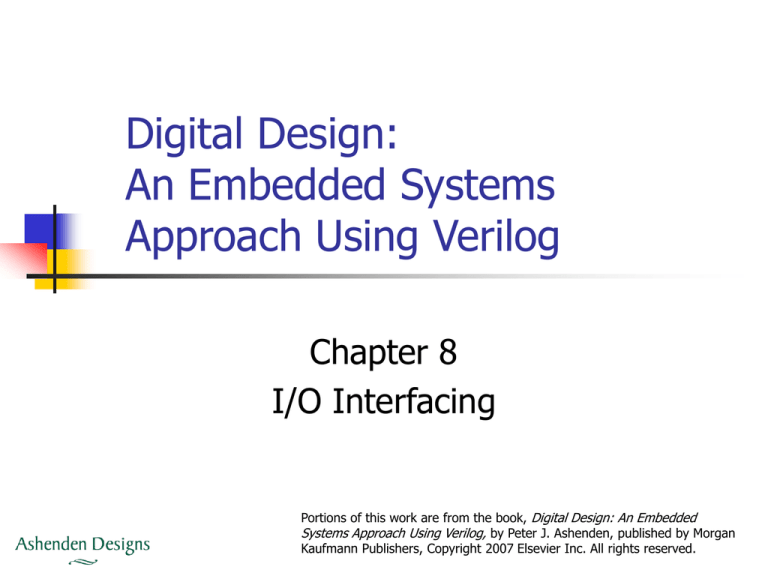
Digital Design:
An Embedded Systems
Approach Using Verilog
Chapter 8
I/O Interfacing
Portions of this work are from the book, Digital Design: An Embedded
Systems Approach Using Verilog, by Peter J. Ashenden, published by Morgan
Kaufmann Publishers, Copyright 2007 Elsevier Inc. All rights reserved.
Verilog
I/O Devices and Transducers
Transducers convert between real-world
effects and digital representation
Input transducers: sensors
Output transducers: actuators
May require analog-to-digital converter (ADC)
May require digital-to-analog converter (DAC)
Human-interface devices
Buttons, switches, knobs, keypads, mouse
Indicators, displays, speakers
Digital Design — Chapter 8 — I/O Interfacing
2
Verilog
Kaypads & Keyboards
Recall switches and debouncing
Keypad: array of push-button switches
+V
1
2
3
4
5
6
r1
r2
7
8
output
register
1
2
3
4
5
6
7
8
9
*
0
#
9
r3
input
register
*
0
#
r4
c1
c2
c3
Digital Design — Chapter 8 — I/O Interfacing
3
Verilog
Knobs & Position Encoders
In analog circuits, use a variable
resistor
In digital circuits, could use
pushbuttons
E.g., volume up/down
Not as easy to use as knobs or sliders
Can use a position encoder attached to
a knob
Recall Gray code encoder
Digital Design — Chapter 8 — I/O Interfacing
4
Verilog
Incremental Encoder
If absolute position is not important,
incremental encoder is simpler
A
B
counterclockwise
A
B
clockwise
AB
Digital Design — Chapter 8 — I/O Interfacing
5
Verilog
Analog Inputs
Physical effect produces an analog voltage or
current
Microphone
Accelerometer
In airbag controllers
Fluid-flow sensors
In phones, cameras, voice recorders, …
In industrial machines, coffee machines, …
Gas detectors
In safety equipment
Digital Design — Chapter 8 — I/O Interfacing
6
Verilog
Analog-to-Digital Converters
Basic element:
analog comparator
Flash ADC
Simple, fast, but
uses many
comparators
Resolution
Number of output
bits
Digital Design — Chapter 8 — I/O Interfacing
7
Verilog
Successive Approximation ADC
(analog)
Vin
Vf
(analog)
SAR
start
DAC
+
–
(analog)
clk
Dout
done
Initial approximation: 01111111
Comparator output gives d7
Next approximation: d70111111
1 if Vin is higher than 01111111, 0 otherwise
Comparator output gives d6
Next approximation: d7d6011111, etc
Digital Design — Chapter 8 — I/O Interfacing
8
Verilog
LED Indicators
Single LED shows 1-bit state
On/off, busy/ready, error/ok, …
+V
Brightness depends on
current
output
driver
Determined by resistor
I = (+V – VLED – VOL) / R
Digital Design — Chapter 8 — I/O Interfacing
9
Verilog
7-Segment LED Displays
Each digit has common anodes or
common cathodes
Scan: turn on one digit at a time
+V
A3
A2
a
b
c
d
e
f
g
dp
common
anode
A1
A0
a
b
c
d
e
f
g
dp
Digital Design — Chapter 8 — I/O Interfacing
10
Verilog
Example: Multiplexed Display
Four BDC inputs, 10MHz clock
Turn on decimal point of leftmost digit only
50Hz scan cycle (200Hz scan clock)
module display_mux ( output reg [3:0] anode_n,
output
[7:0] segment_n,
input
[3:0] bcd0, bcd1, bcd2, bcd3,
input
clk, reset );
parameter clk_freq
= 10000000;
parameter scan_clk_freq = 200;
parameter clk_divisor
= clk_freq / scan_clk_freq;
reg
scan_clk;
reg [1:0] digit_sel;
reg [3:0] bcd;
reg [7:0] segment;
integer count;
Digital Design — Chapter 8 — I/O Interfacing
11
Verilog
Example: Multiplexed Display
// Divide master clock to get scan clock
always @(posedge clk)
if (reset) begin
count = 0;
scan_clk <= 1'b0;
end
else if (count == clk_divisor - 1) begin
count = 0;
scan_clk <= 1'b1;
end
else begin
count = count + 1;
scan_clk <= 1'b0;
end
// increment digit counter once per scan clock cycle
always @(posedge clk)
if
(reset)
digit_sel <= 2'b00;
else if (scan_clk) digit_sel <= digit_sel + 1;
Digital Design — Chapter 8 — I/O Interfacing
12
Verilog
Example: Multiplexed Display
// multiplexer to select a BCD digit
always @*
case (digit_sel)
2'b00: bcd = bcd0;
2'b01: bcd = bcd1;
2'b10: bcd = bcd2;
2'b11: bcd = bcd3;
endcase
// activate selected
always @*
case (digit_sel)
2'b00: anode_n =
2'b01: anode_n =
2'b10: anode_n =
2'b11: anode_n =
endcase
digit's anode
4'b1110;
4'b1101;
4'b1011;
4'b0111;
Digital Design — Chapter 8 — I/O Interfacing
13
Verilog
Example: Multiplexed Display
// 7-segment
always @*
case (bcd)
4'b0000:
4'b0001:
4'b0010:
4'b0011:
4'b0100:
4'b0101:
4'b0110:
4'b0111:
4'b1000:
4'b1001:
default:
endcase
decoder for selected digit
segment[6:0]
segment[6:0]
segment[6:0]
segment[6:0]
segment[6:0]
segment[6:0]
segment[6:0]
segment[6:0]
segment[6:0]
segment[6:0]
segment[6:0]
=
=
=
=
=
=
=
=
=
=
=
7'b0111111;
7'b0000110;
7'b1011011;
7'b1001111;
7'b1100110;
7'b1101101;
7'b1111101;
7'b0000111;
7'b1111111;
7'b1101111;
7'b1000000;
//
//
//
//
//
//
//
//
//
//
//
0
1
2
3
4
5
6
7
8
9
"-"
Digital Design — Chapter 8 — I/O Interfacing
14
Verilog
Example: Multiplexed Display
// decimal point is only active for digit 3
always @* segment[7] = digit_sel == 2'b11;
// segment outputs are negative logic
assign segment_n = ~segment;
endmodule
Digital Design — Chapter 8 — I/O Interfacing
15
Verilog
Liquid Crystal Displays (LCDs)
Advantages
Disadvantages
Low power
Readable in bright ambient light conditions
Custom segment shapes
Require backlight for dark conditions
Not as robust as LEDs
LCD panels
Rectangular array of pixels
Can be used for alphanumeric/graphical display
Controlled by a small microcontroller
Digital Design — Chapter 8 — I/O Interfacing
16
Verilog
Actuators & Valves
Actuators cause a mechanical effect
Solenoid: current in coil moves armature
Solenoid valve
Can attach rods, levers, etc
to translate the movement
Armature controls fluid
or gas valve
Relay
Armature controls
electrical contacts
Digital Design — Chapter 8 — I/O Interfacing
17
Verilog
Motors
Can provide angular position or speed
Use gears, screws, etc to convert to linear
position or speed
Stepper motors
Rotate in discrete steps
N
S
S
N
S N
N
S
S N
N S
N S
S
N
Digital Design — Chapter 8 — I/O Interfacing
18
Verilog
Motors
Servo-motors
DC motor, speed controlled by varying the
drive voltage
Use feedback to control the speed or to
drive to a desired position
Requires a position sensor or tachometer
Servo-controller
A digital circuit or an embedded processor
Compensates for non-ideal mechanical
effects
Digital Design — Chapter 8 — I/O Interfacing
19
Verilog
Digital-to-Analog Converters
R-string DAC
Voltage divider
and analog
multiplexer
Requires 2n
precision
resistors
Digital Design — Chapter 8 — I/O Interfacing
20
Verilog
Digital-to-Analog Converters
Vf
R-2R ladder DAC
Sums binaryweighted
currents
Requires 2n
matched
resistors
a(3)
a(2)
a(1)
a(0)
2R
2R
2R
2R
–
+
2R
Vout
R
R
R
2R
Digital Design — Chapter 8 — I/O Interfacing
21
Verilog
I/O Controllers
An embedded processor needs to
access input/output data
I/O controller
Circuit that connects I/O device to a
processor
Includes control circuits
Input registers: for reading data
Output registers: for writing data
I/O ports
Registers accessible to embedded software
Digital Design — Chapter 8 — I/O Interfacing
22
Verilog
Simple I/O Controller
Just contains input and/or output
registers
Select among them using a port address
module gumnut ( input
clk_i,
input
rst_i,
...
output
port_cyc_o,
output
port_stb_o,
output
port_we_o,
input
port_ack_i,
output [7:0] port_adr_o,
output [7:0] port_dat_o,
input [7:0] port_dat_i,
... );
endmodule
Digital Design — Chapter 8 — I/O Interfacing
23
Verilog
Example: Keypad Controller
Output register for row drivers
Input register for column sensing
Gumnut
Keypad Controller
1 2 3
port_adr_o
port_dat_i
port_dat_o
dat_i
port_ack_i
port_cyc_o
cyc_i
port_we_o
we_i
keypad_col
port_stb_o
stb_i
dat_o
keypad_port_
addr
=
keypad_row
4 5 6
7 8 9
* 0 #
ack_o
Digital Design — Chapter 8 — I/O Interfacing
24
Verilog
Example: Keypad Controller
module keypad_controller ( input
clk_i,
input
cyc_i,
input
stb_i,
input
we_i,
output
ack_o,
input
[7:0] dat_i,
output reg [7:0] dat_o,
output reg [3:0] keypad_row,
input
[2:0] keypad_col );
reg [2:0] col_synch;
always @(posedge clk_i) // Row register
if (cyc_i && stb_i && we_i) keypad_row <= dat_i[3:0];
always @(posedge clk_i) begin // Column synchronizer
dat_o
<= {5'b0, col_synch};
col_synch <= keypad_col;
end
assign ack_o = cyc_i && stb_i;
endmodule
Digital Design — Chapter 8 — I/O Interfacing
25
Verilog
Control/Status Registers
Control register
Status register
Contains bits that govern operation of the
I/O device
Written by processor
Contains bits that reflect status of device
Read by processor
Either or both may be needed in an
input or output controller
Digital Design — Chapter 8 — I/O Interfacing
26
Verilog
Example: ADC Controller
Successive approximation ADC
Control register
Selects reference voltage
Hold input voltage & start ADC
Status register
1 × analog input with sample/hold
4 × analog reference voltages
Is conversion done?
Input data register
Converted data
Digital Design — Chapter 8 — I/O Interfacing
27
Verilog
Example: ADC Controller
Digital Design — Chapter 8 — I/O Interfacing
28
Verilog
Autonomous I/O Controllers
Independently sequence operation of a
device
Processor initiates actions
Controller notifies processor of events,
such as data availability, error condition, …
Processor can perform other operations
concurrently
Device operation not limited by
processor performance or load
Digital Design — Chapter 8 — I/O Interfacing
29
Verilog
Example: LCD Module
Rectangular array of pixels
Row and column connections
Controller scans rows, activates columns
Image or character data stored in a
small memory in the controller
Updated by an attached processor
Digital Design — Chapter 8 — I/O Interfacing
30
Verilog
Direct Memory Access (DMA)
For high-speed input or output
Processor writes starting address to a
control register
Controller transfers data to/from memory
autonomously
Notifies processor on completion/error
Reduces load on processor
Common with accelerators
Digital Design — Chapter 8 — I/O Interfacing
31
Verilog
Parallel Buses
Interconnect components in a system
Conceptual structure
Transfer bits of data in parallel
All inputs and
output connected
In practice
Can’t tie
multiple outputs
together
data
source
data
source
Digital Design — Chapter 8 — I/O Interfacing
data
destination
data
destination
data
destination
32
Verilog
Multiplexed Buses
Use multiplexer(s)
to select among
data sources
Can partition to
aid placement on chip
data
source
data
destination
0
1
data
source
Digital Design — Chapter 8 — I/O Interfacing
data
destination
data
destination
33
Verilog
Example: Wishbone Bus
Non-proprietary bus spec
OpenCores Organization
Gumnut uses simple form of Wishbone
One bus for each of instruction memory,
data memory, and I/O ports
“…_o” denotes output
“…_i” denotes input
Digital Design — Chapter 8 — I/O Interfacing
34
Verilog
Example: Wishbone Bus
Keypad Controller
=4
Gumnut
port_adr_o
dat_i
dat_o
cyc_i
ack_o
we_i
stb_i
ADC Controller
adr_i(0)
0
0
port_dat_i
port_dat_o
dat_i
dat_o
port_ack_i
port_cyc_o
cyc_i
ack_o
port_we_o
we_i
port_stb_o
stb_i
1
0
1
= 0...1
ADC Controller
adr_i(0)
0
0
dat_i
dat_o
cyc_i
ack_o
1
0
1
we_i
= 2...3
stb_i
Digital Design — Chapter 8 — I/O Interfacing
35
Verilog
Tristate Buses
Use tristate drivers for data sources
Can “turn-off” (Hi-Z) when not supplying data
Simplified bus wiring
Digital Design — Chapter 8 — I/O Interfacing
36
Verilog
Tristate Bus Issues
Floating bus can cause spurious switching
Use pull-up resistors or weak keepers
Need to avoid driver contention
Dead cycle between
turn-off and turn-on
Or delayed enable
d
d_bus
weak
drive
en
Not all CAD tools and implementation
fabrics support tristate buses
Digital Design — Chapter 8 — I/O Interfacing
37
Verilog
Tristate Drivers in Verilog
Assign Z to an output to turn driver off
Example: single-bit driver
Example: multi-bit driver
assign d_out = d_en ? d_in
: 1'bZ;
assign bus_o = dat_en ? dat
: 8'bZ;
Any other driver contributing 0 or 1
overrides Z value
Digital Design — Chapter 8 — I/O Interfacing
38
Verilog
Example: SN74x16541
Same as wire,
but indicates
tristate driver
module sn74x16541 ( output tri [7:0] y1, y2,
input
[7:0] a1, a2,
input
en1_1,
en1_2,
en2_1,
en2_2 );
assign y1 = (~en1_1 & ~en1_2) ? a1 : 8'bz;
assign y2 = (~en2_1 & ~en2_2) ? a2 : 8'bz;
endmodule
Digital Design — Chapter 8 — I/O Interfacing
39
Verilog
Unknown Values in Verilog
What if two drivers are turned on?
One driving 0, the other driving 1
Resolved value is X — unknown
Can test for X during simulation
Use === and !== operators
C.f. == and !=, which are logical equivalence
and inequivalence tests
Z and X are not electrical logic levels
Notations for simulation and synthesis
Real logic levels are only 0 or 1
Digital Design — Chapter 8 — I/O Interfacing
40
Verilog
Open-Drain Buses
Bus is 0 if any driver pulls it low
If all drivers are off, bus is pulled high
Wired-AND
Can also use
open-collector drivers
Digital Design — Chapter 8 — I/O Interfacing
41
Verilog
Open-Drain Drivers in Verilog
Assign 0 or 1 to model driver
Model pull-up on open-drain bus using
wand net
wand bus_sig;
Resolved value is logical AND of driver
values
Digital Design — Chapter 8 — I/O Interfacing
42
Verilog
Bus Protocols
Specification of signals, timing, and
sequencing of bus operations
Allows independent design of components
Ensures interoperability
Standard bus protocols
PCI, VXI, …
For connecting boards in a system
AMBA (ARM), CoreConnect (IBM),
Wishbone (Open Cores)
For connecting blocks within a chip
Digital Design — Chapter 8 — I/O Interfacing
43
Verilog
Example: Gumnut Wishbone
Minimal 8-bit subset used for I/O ports
Signals
port_cyc_o: “cycle” control for sequence of port
operations
port_stb_o: “strobe” control for an operation
port_we_o: write enable
port_ack_i: acknowledge from addressed port
port_adr_o: 8-bit port address
port_dat_o: 8-bit data output from Gumnut
port_dat_i: 8-bit data input to Gumnut
Digital Design — Chapter 8 — I/O Interfacing
44
Verilog
Gumnut Wishbone Write
clk
port_adr_o
port_dat_o
port_cyc_o
port_stb_o
port_we_o
port_ack_i
No wait cycles
One wait cycle
Digital Design — Chapter 8 — I/O Interfacing
45
Verilog
Gumnut Wishbone Read
clk
port_adr_o
port_cyc_o
port_stb_o
port_we_o
port_dat_i
port_ack_i
No wait cycles
One wait cycle
Digital Design — Chapter 8 — I/O Interfacing
46
Verilog
Serial Transmission
Bits transmitted one after another on a single
wire
Can afford to optimize the wire for speed
C.f. parallel transmission, one wire per bit
Requires more wires
Requires more pins
Cost of larger package
Other effects
Cost per wire, greater area for wiring, complexity of
place & route
Crosstalk, skew, delay due to increased area
Serializer/deserializer (serdes)
Converts between parallel and serial form
Digital Design — Chapter 8 — I/O Interfacing
47
Verilog
Example: 64-bit Serdes
tx_D
start
reset
clk
+V
64-bit
shift reg
D_in
D
Q0
load_en
CE
clk
64-bit
shift reg
serial_D
D_in
receiver
control
start rx_ce
reset
clk rx_rdy
Q
rx_D
CE
clk
rx_rdy
Bit order is
arbitrary,
provided both
ends agree
Digital Design — Chapter 8 — I/O Interfacing
Often specified
by standards
48
Verilog
NRZ Transmission
Non-Return to Zero
Just set signal to high or low for each bit time
No indication of boundary between bit times
Need to synchronize transmitter and receiver
separately
E.g., by a common clock and control signals, as in
previous example
Digital Design — Chapter 8 — I/O Interfacing
49
Verilog
Start/Stop Bit Synchronization
Hold signal high when there is no data
To transmit
Drive signal low for one bit time (start bit)
Then drive successive data bits
Then drive signal high for one bit time
(stop bit)
Digital Design — Chapter 8 — I/O Interfacing
50
Verilog
UARTs
Universal Asynchronous
Receiver/Transmitter
Common I/O controller for serial
transmission using NRZ with start/stop bits
Relies on Tx and Rx clocks being
approximately the same frequency
Digital Design — Chapter 8 — I/O Interfacing
51
Verilog
Manchester Encoding
Combine Tx clock with Tx data
Ensures regular edges in the serial signal
Example: Manchester encoding
Transition in the middle of each bit time
0: low-to-high transition
1: high-to-low transition
May need a transition at the start of a bit time
Digital Design — Chapter 8 — I/O Interfacing
52
Verilog
Clock Recovery
Transmitter sends preamble before data
A sequence of encoded 1 bits
Serial signal then matches Tx clock
Receiver uses a phase-locked loop (PLL) to
match Rx clock to Tx clock
Digital Design — Chapter 8 — I/O Interfacing
53
Verilog
Serial Interface Standards
Connection of I/O devices to computers
Connection of computers in networks
Use of standards reduces design effort
Reuse off-the-shelf components or IP
RS-232: NRZ, start/stop bits
Originally for modems, now widely used for
low-bandwidth I/O
Digital Design — Chapter 8 — I/O Interfacing
54
Verilog
Serial Interface Standards
I2C: Inter-Integrated Circuit bus
USB: Universal Serial Bus
2 wires (NRZ data, clock), open drain
Simple protocol, low cost, 10kb/s–3.4Mb/s
For connecting I/O devices to computers
Differential signaling on 2 wires
1.5Mb/s, 12Mb/s, 480Mb/s, …, complex protocl
IP blocks available
FireWire: IEEE Std 1394
2 differential pairs (data, synch)
400Mb/s, 3.2Gb/s, complex protocol
Digital Design — Chapter 8 — I/O Interfacing
55
Verilog
I2C Example: Temperature Sensor
Gumnut, Analog Devices AD7414
I2C controller IP from OpenCores respository
Digital Design — Chapter 8 — I/O Interfacing
56
Verilog
I/O Software
Use input and output instructions to
access I/O controller registers
I/O devices interact with the physical
world
Software must respond to events when
they occur
It must be able schedule activity at specific
times or at regular intervals
Real-time behavior
Digital Design — Chapter 8 — I/O Interfacing
57
Verilog
Polling
Software repeatedly reads I/O status to see if
an event has occurred
Multiple controllers
If so, it performs the required action
Software executes a polling loop, checking
controllers in turn
Advantage: simple I/O controllers
Disadvantages
Processor is continually busy, consuming power
Delay in dealing with an event if processor is busy
with another event
Digital Design — Chapter 8 — I/O Interfacing
58
Verilog
Polling Example
Safety monitor in factory automation
Gumnut core
16 alarm inputs
Temp sensor ADC at address 20
One per bit in registers at addresses 16 & 17
0 ok, 1 abnormal condition
8-bit binary code for °C
Above 50°C is abnormal
Alarm output at address 40
0 ok, 1 ring alarm bell
Digital Design — Chapter 8 — I/O Interfacing
59
Verilog
Polling Example
alarm_in_1:
alarm_in_2:
temp_in:
alarm_out:
max_temp:
equ
equ
equ
equ
equ
16
17
20
40
50
poll_loop:
inp
sub
bnz
inp
sub
bnz
inp
sub
bnc
out
jmp
add
out
jmp
r1, alarm_in_1
r0, r1, 0
set_alarm ; one or more alarm_in_1 bits set
r1, alarm_in_2
r0, r1, 0
set_alarm ; one or more alarm_in_2 bits set
r1, temp_in
r0, r1, max_temp
set_alarm ; temp_in > max_temp
r0, alarm_out ; clear alarm_out
poll_loop
r1, r0, 1
r1, alarm_out ; set alarm_out bit 1 to 1
poll_loop
set_alarm:
;
;
;
;
;
address
address
address
address
maximum
of alarm_in_1 input register
of alarm_in_2 input register
of temp_in input register
of alarm_out output register
permissible temperature
Digital Design — Chapter 8 — I/O Interfacing
60
Verilog
Interrupts
I/O controller notifies processor when an
event occurs
Processor interrupts what it was doing
Executes interrupt service routine
A.k.a. interrupt handler
Then resumes interrupted task
May enter low-power standby
Some systems prioritize interrupt requests
Allow higher priority events to interrupt service of
lower priority events
Digital Design — Chapter 8 — I/O Interfacing
61
Verilog
Interrupt Mechanisms
Interrupt request signal
Means of disabling/enabling interrupts
Save processor state on an interrupt
Until processor has saved state
Find the handler code for the event
So interrupted task can be resumed
On interrupt, disable further interrupts
So processor can execute critical regions
Vector: address of handler, or index into table of
handler addresses
Instruction to return from handler
Restoring saved state
Digital Design — Chapter 8 — I/O Interfacing
62
Verilog
Gumnut Interrupt Mechanisms
int_req signal
disi and enai instructions
On interrupt, PC, Z, and C saved in special
registers
On interrupt, further interrupts are disabled
Handler code starts at address 1
Gumnut sets PC to 1
reti instruction
Restores PC, Z, and C from special registers, reenables interrupts
Digital Design — Chapter 8 — I/O Interfacing
63
Verilog
Interrupt Acknowledgment
Process may not respond immediately
But must tell controller when it does
Controller then deactivates request
To avoid multiple interrupts for one event
Processor acknowledges the request
E.g., int_ack signal on Gumnut
Alternative: reading a status register
Digital Design — Chapter 8 — I/O Interfacing
64
Verilog
Example: Sensor Controller
8-bit input from sensor
Interrupt request on change of value
dat_o
sensor_in
int_ack
rst_i
clk_i
cyc_i
stb_i
D
Q
reset
clk
D
Q
reset
clk
≠
D
Q
reset
clk
int_req
ack_o
Digital Design — Chapter 8 — I/O Interfacing
65
Verilog
Example: Sensor Handler
saved_r1:
data
bss
1
sensor_data:
text
equ
0
org
stm
inp
...
ldm
reti
; address of sensor data
; input register
1
r1, saved_r1
r1, sensor_data
; process the data
r1, saved_r1
Digital Design — Chapter 8 — I/O Interfacing
66
Verilog
Timers
Real-time clock (RTC)
Generates periodic interrupts
Uses a counter to divide system clock
Control register for divisor
Interrupt handler can perform periodic
tasks
E.g., activate next digit of a scanned
display
Digital Design — Chapter 8 — I/O Interfacing
67
Verilog
Example: RTC for Gumnut
10µs timebase, divided by a down
counter
Initial count loaded from a register
Interrupt triggered on count value = 0
Offset
Output Registers
Input Registers
0
start_count
count_value
1
– – – – – – – E
0 0 0 0 0 0 0 I
Interrupt
Enable
Interrupt
Triggered
Digital Design — Chapter 8 — I/O Interfacing
68
Verilog
Real-Time Executives
Control program
A.k.a. real-time operating system (RTOS)
Timing based on a real-time clock
Schedules execution of tasks
In response to interrupts and timer events
Can also manage other resources
Memory allocation
Storage (file system)
Use of I/O controllers
Use of accellerators
Digital Design — Chapter 8 — I/O Interfacing
69
Verilog
Example: Gumnut Executive
RTC based at address 16
Calls task_2ms every 2ms
;;; --------------------------------------------------------;;; Program reset: jump to main program
text
org
jmp
0
main
;;; --------------------------------------------------------;;; Port addresses
rtc_start_count:
rtc_count_value:
rtc_int_enable:
rtc_int_status:
equ
equ
equ
equ
16
16
17
17
;
;
;
;
data output register
data input register
control output register
status input register
Digital Design — Chapter 8 — I/O Interfacing
70
Verilog
Example: Gumnut Executive
;;; --------------------------------------------------------;;; init_interrupts:
Initialize 2ms periodic interrupt, etc.
rtc_divisor:
data
equ
199
rtc_int_flag:
bss
1
text
add
out
add
out
stm
...
ret
r1, r0, rtc_divisor
r1, rtc_start_count
r1, r0, 1
r1, rtc_int_enable
r0, rtc_int_flag
; other initializations
init_interrupts:
; divide 100kHz down
; to 500Hz
Digital Design — Chapter 8 — I/O Interfacing
71
Verilog
Example: Gumnut Executive
;;; --------------------------------------------------------;;; Interrupt handler
int_r1:
data
bss
text
org
int_handler:
check_rtc:
stm
inp
sub
bz
add
stm
check_next:
...
int_end:
ldm
reti
1 ; save location for
; handler registers
1
r1, int_r1
; save registers
r1, rtc_status ; check for
; RTC interrupt
r0, r1, 0
check_next
r1, r0, 1
r1, rtc_int_flag ; tell main
; program
r1, int_r1 ; restore registers
Digital Design — Chapter 8 — I/O Interfacing
72
Verilog
Example: Gumnut Executive
;;; --------------------------------------------------------;;; main program
main:
main_loop:
main_next:
text
jsb
enai
stby
ldm
sub
bnz
jsb
stm
...
jmp
init_interrupts
r1, rtc_int_flag
r0, r1, 1
main_next
task_2ms
r0, rtc_int_flag
main_loop
Note: task_2ms not called as part of interrupt
handler
Would slow down response to other interrupts
Digital Design — Chapter 8 — I/O Interfacing
73
Verilog
Summary
Transducers: sensors and actuators
Input and output devices
Controllers
Analog-to-digital and digital-to-analog
coverters
Input, output, control, and status registers
Autonomous controllers
Buses: multiplexed, tristate, open-drain
Bus protocols: signals, timing, operations
Digital Design — Chapter 8 — I/O Interfacing
74
Verilog
Summary
Serial transmission
Real-time software
NRZ, embedded clock
Reacting to I/O and timer events
Polling, interrupts
Real-time executives
Digital Design — Chapter 8 — I/O Interfacing
75

